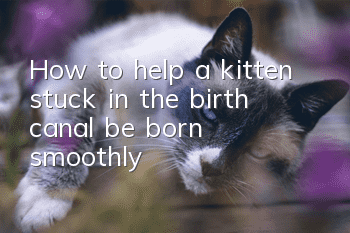How to help a kitten stuck in the birth canal be born smoothly?

The problem of dystocia in female cats is quite difficult for any breeder to encounter.
Sometimes, we may have to resort to caesarean section to solve the problem. However, caesarean section will indeed have a lot of negative effects on the future breeding career of the female cat, so unless it is very necessary, it is best not to blindly perform caesarean section. There are many reasons why a female cat has dystocia, but no matter what the reason is, fundamentally it is because the kitten is stuck somewhere in the birth canal and cannot come out.
Experienced breeders will use their fingers to explore the female cat's birth canal to determine the cause of the obstruction. If circumstances permit, you can use your fingers to help a stuck kitten to be born smoothly. Many veterinarians and veteran breeders are very skilled in this midwifery skill.
In fact, it is not difficult. After mastering the basic essentials and practicing a few times, you can master this skill.
▍Reduction of the birth process
Before introducing this skill, let’s first restore the process of a kitten’s birth in the uterus and birth canal. Once you have a clear understanding of the process, you will be more aware of it during the practical stage. After the female cat enters the second stage of delivery, uterine contractions begin to become frequent and strong. At this time, a kitten in a certain uterine angle will be squeezed into the vicinity of the cervix under the push.
A kitten that enters near the cervix will continue to push the cervix, causing the cervix to open. Once, the cervix is opened. The kitten will slide into the vagina. The outer capsule usually ruptures before the kitten is born, and some of the straw-colored fluid inside lubricates the vagina and drains out. This is what we often call amniotic fluid. Usually, kittens are born within a few minutes under normal circumstances. A kitten's head is usually born first. Once the head is born, the rest is easier because the head is usually the widest part of the kitten's body. After the kitten is born, the placenta will come out immediately. Sometimes the placenta may take a while, so be sure to count it carefully. An additional point to note here is that once the kitten leaves the uterus and enters the vagina, it means that the placenta begins to break away from the uterine wall, and the mother cat's oxygen supply will also be cut off at the same time. Therefore, if the kitten stays in the vagina for more than 15 minutes (the starting point of this time can be calculated from when the amniotic water breaks), the kitten is at risk of dying due to lack of oxygen. Therefore, we must find a way to make it born immediately.
▍Analysis of causes of dystocia
There are two main types of causes for kittens getting stuck and dystocia. One is related to the mother cat, and the other is related to the kitten. Let’s summarize it in parts.
Reasons related to female cats There are three main reasons related to female cats: 1. Pelvic problems: pelvic narrowing, pelvic deformity, pelvic obstruction 2. Uterine atony: divided into primary and secondary 3. Uterine torsion: torsionOr break
Regarding uterine atony and uterine torsion, we have a special course to discuss it, which can be learned at the end of the article.
Reasons related to kittens If the following conditions occur, kittens will be easily stuck: 1. Wrong position:
The head has entered the vagina, but one leg is outward, trapping the kitten's body in the cervix.
My legs have entered near the cervix, but my head is tilted and I cannot open the cervix smoothly.
The legs are close to the kitten's body. The whole kitten is too wide and cannot easily pass through the cervix.
2. The body of the kitten is too wide for the width of the mother cat’s pelvis: This is more common in a litter of only one or two kittens, because the kittens will grow very large before delivery. 3. The kitten’s head is too big, and the mother cat’s pelvis cannot open such a wide opening: This situation is more common in flat-faced breeds. 4. Fetal malformation 5. The kitten dies: If the kitten dies in the womb, the tissue will rot and the body will swell, making it more difficult to move down. In addition, the mother cat's uterine contractions are stimulated by the downward movement of the kitten, and this stimulation disappears if the kitten dies. 6. The placenta of the first-born kitten blocked the birth canal
▍Signs of a stuck kitten
If the female cat has strong and frequent contractions but cannot give birth to kittens for a long time, then you should suspect that one of the kittens may be stuck.
There are two situations here: one situation is that you can clearly see that there is already a part of the kitten's body at the vaginal opening, maybe a piece of the head, a little foot, or the heel of the tail. But this exposed part will move in and out with strong contractions. In fact, this situation is relatively easy to handle. The second situation is that you can't see the kitten in the vagina, but the female cat has severe contractions that have lasted for some time. At this time, you may need to put your finger in to detect it.
▍How to detect
To know the status of the kittens in the birth canal, insert your fingers into the female cat's vagina. The method is not as difficult as you think, as long as you are bold and careful. However, during operation, defensive measures also need to be taken. It's best to do this with two people. The first thing to do is to wrap each of the female cat's feet with a wide piece of scotch tape or a self-adhesive bandage. This is to prevent her from kicking you in a hurry. Secondly, wear an Elizabethan collar on the female cat to prevent it from biting you.
Finally, if the female cat resists very fiercely, you need someone to help you and hold her front and rear legs. After completing the above safety measures, you can prepare for "detection".
You need to wear disposable sterile latex gloves and apply it on your index or middle fingerHuman lubricant, after cleaning the female cat’s vulva with a wet wipe, you can start. Place one hand under the female cat's belly in front of the pelvis and press upward between the hind legs, first touching the kitten from the outside.
Once you feel a kitten, straighten it so that it is aligned with the birth canal. Insert the fingers of your other hand into the female cat's vagina and feel inside. You should be able to feel the head, tail, or legs. In this regard, different measures must be taken according to different situations. I will explain them in categories below.
In addition, you don’t have to worry about hurting the female cat with your fingers. Because your fingers are much narrower than a kitten's body. What you need to pay attention to is that you don't have long nails, which may scratch the inner wall of the vagina.
▍If the kitten is stuck: head out
When the kitten’s head or front feet are visible at the female cat’s labia, but the female cat has not given birth to a kitten after many severe contractions, you can use the following methods when the female cat is having contractions:
Repeatedly pushing and pushing out the parts on both sides of the perineum (between the anus and vagina). This action can encourage the mother cat to push the kittens out harder.
Next, gently grab the kitten's head and pull it out of the labia, so that the head will no longer be sucked back with the contractions. Once the head is out, tear the amniotic sac, wipe the membrane off the nose and mouth, and allow the kitten to breathe.
Then, use a piece of sterile gauze to grasp the skin on the back of the kitten's neck, and gently pull the kitten out in the direction of the mother cat's strength. Use gauze to prevent slipping.
Remember, never pull a kitten by its head or legs, as this can damage the joints. If it's not easy to pull, try adjusting the angle slightly.
▍If the kitten is stuck: head tilted to one side
If your fingers do not feel the kitten's head in the birth canal, but only its front legs and chest, this means that the head is not facing forward, but is tilted. In this case, you need to straighten the position of its head. The method is as follows: first, bring the protruding parts you feel, such as legs, chest, or other parts, into the vagina, that is, backward. push. Push until you can feel the kitten's head. At this time, slide your fingers around the kitten's head, and make clockwise circles around the head along the vaginal wall. You can apply appropriate force to the vaginal wall, and at the same time, you can gently hook the kitten out to keep it in the correct posture. Enter the birth canal. After the above operations, the kitten will probably come out along with the force of contractions.
▍If the kitten is stuck: the legs are close to the body Regardless of whether the kitten comes out head first or butt first, ideally, the front or back legs should be straight and pointed in the direction of the vaginal exit. However, many times the legs are folded against the kitten's body, but this usually does not cause dystocia.
There are exceptions, however, if the entire body becomes too wide after folding. Some female cats may not be able to give birth. Sometimes, it may be because the thickness of the legs and the thickness of the shoulders combined are too wide, causing the shoulders to get stuck on the kitten. The solution generally is to straighten the kitten's legs forward so that they are in the same direction as the head.
The operation method is as follows: Same as the above situation, draw a few circles around the head or buttocks. Sometimes you straighten your legs while circling, and the kitten may even come out directly.
If not, carefully touch the folded leg, hook it with your fingers, and pull it forward. Just straighten it.
▍If the kitten is stuck by retained placenta
Sometimes the birth canal is blocked by the placenta from the kitten that was born first. If this happens you can manually pull the placenta out. The method is as follows: After inserting your fingers into the vagina, hook the placenta. If the placenta is already at the vaginal opening, you can use gauze to pull it. Then pull it out slowly, and be sure not to use force, otherwise it may easily cause damage to the uterus or vagina.
▍If the female cat stops contracting
Sometimes the kitten may be half born and unable to be born. This is not caused by being stuck, but because the female cat's contractions have stopped or are weak. She may be tired, or her muscles may be overstrained. In this case, oxytocin is recommended. I will talk about the timing of using oxytocin in detail in another lesson.
▍If the kitten is too big and gets stuck
Sometimes, a kitten is so big that it becomes trapped in the birth canal. This situation may require an immediate caesarean section. If you cannot get to the hospital in time, it is best to grab the kitten and pull it out (even if there is a risk of the kitten being injured or killed) so that other kittens behind it can be born. If you delay for too long, the mother cat's life will be in danger, and all other kittens will die. Therefore, it is still necessary to take prenatal radiographs so that the size of the litter can be assessed.
▍Go to the vet
It is usually too late to seek help from a veterinarian. Unless you hospitalize the female cat in advance during labor. Of course, this is extremely not recommended. Therefore, each breeder needs to hone their midwifery skills.
However, if any of the following conditions occur, you should go to the hospital as soon as possible:
30-60 minutes of intense contractions, but still no kittens born.
The vesicle has appeared at the vaginal opening, but after 15-30 minutes of strong contractions, the baby is still not born. You corrected yourself as a kitten, but still failed.
High fever above 39.5℃.
Fresh blood flows from the mother cat's vagina for more than 10 minutes before or after giving birth to kittens.
Thick, black, unpleasant-smelling vaginal discharge.
Labor stops and the cat shows signs of extreme anxiety, weakness, or fatigue.
▍Summary
If you have never touched a kitten in a female cat’s vagina. You can feel it when a female cat gives birth next time. When you know what kind of situation is normal, you will know what abnormal situations look like. Experience is accumulated and explored. If this skill can be mastered, stuck kittens usually do not need to be delivered by caesarean section. Article source: Cat Academy
- How do you judge the appearance of Garfield cat?
- Can cats eat dried fish? What are the taboos for cats eating dried fish?
- What should I do if my cat is too timid? How can I improve my cat’s courage?
- Why do cats like to bite things?
- Introduction to the causes of oral ulcers in cats
- What level of protection is the prairie spotted cat?
- Why does the blue cat’s hair turn yellow?
- What are the signs that a cat is pregnant and about to give birth?
- What kind of cat food is good for kittens to eat during their rapid growth period?
- What are the symptoms of a cat entering estrus?



